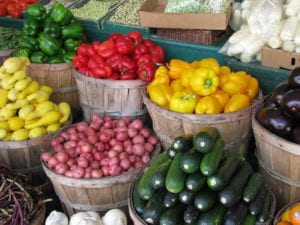Food Fresh from the Farm
 We’ve all heard the adage “You are what you eat.” As we acknowledge and embrace the truth of this assertion, many of us are starting to take a closer look at what we put into our bodies. Whether you’re exploring fresh foods, raw foods, organic foods, or simply more natural foods that haven’t had all of the natural nutrition processed out of them, this can become either a casual quest or an ongoing obsession.
We’ve all heard the adage “You are what you eat.” As we acknowledge and embrace the truth of this assertion, many of us are starting to take a closer look at what we put into our bodies. Whether you’re exploring fresh foods, raw foods, organic foods, or simply more natural foods that haven’t had all of the natural nutrition processed out of them, this can become either a casual quest or an ongoing obsession.
Truly fresh food is still alive. The sooner you eat it from the time that it’s picked, the higher the concentration of enzymes, vitamins and nutrients. Most of the produce in grocery stores was picked prematurely, before the food is fully ripe, and then treated with preservatives to maximize shelf life. There are farms where you can actually pick vegetables yourself, but a more convenient way to get fresh food is to go to a farmers’ market.
At farmers’ markets, you can find a wide variety of organic vegetables, hormone-free dairy products, and meat from animals that are usually raised in a healthy and humane way. Other staples include healthy whole-grain breads, fresh cheese, homemade jelly, fresh eggs, nuts and honey. You can also buy a wide variety of herbs and spices, including live plants to grow in your own backyard, plus hand-crafted artwork and gifts, natural soaps and candles. Plus, more money goes directly to the farmer, not to the corporate middlemen that maximize their profits while putting price pressures on the producers.
An increasing number of people are making regular trips to farmers’ markets for these staple food items. This is a great way to get closer to the source, and actually meet the people who are growing your food. Farmers’ markets are lively, social environments, where like-minded people come together in a festive atmosphere. There’s often live entertainment, with friendly people behind the counter who are always willing to share tips and explain things. It’s a culture that actively promotes sustainable agriculture.
Most farmers’ markets operate six months out of the year, typically from late April or early May through the end of October. They tend to be loosely organized affiliations of farmers that come together on a weekly basis to sell their harvest, cutting out the middleman to market directly to the consumer. There are nearly 200 farmers’ markets in Missouri, a number which has risen dramatically in the last ten years.
The Soulard Market, which is the oldest farmers’ market west of the Mississippi, is open year round. This attracts a large crowd, especially on Saturday morning, and has a large variety of vendors. The truth is, Soulard Market is much more than a farmers’ market, as many growers supplement their own crops with produce from other parts of the country, reselling the same foods that you can purchase in the grocery store. Of course, foods can be grown here year round in greenhouses, so if you’re interested in buying fresher, locally grown foods, be sure to ask.
Now, for bananas, pineapples and kiwi, it may seem like a no-brainer that they’re not from around here. But other foods that are grown locally are often trucked in from faraway places. So it’s important to understand what’s in season, and then plan seasonal menus around that. Food items that are in season are much more affordable simply because they’re plentiful. Just witness the price of tomatoes in the summer vs. the winter for evidence of this.
In the Midwest, you can get…
- Asparagus and leafy greens starting in April
- Strawberries, broccoli , radishes starting in May
- Beans, peas and celery starting in June
- Peppers, melons, tomatoes and zucchini starting in July
- Apples, cauliflower, celery and grapes starting in August
- Pumpkins, beans and greens in September and October.
The Tower Grove Farmer’s Market provides a more comprehensive crop calendar that shows which fruits and vegetables are generally available in which months.
Many of the farmers who market their products in these venues are getting back in touch with their roots, using sustainable farming methods that promote biodiversity and make a positive impact on local ecosystems. Supporting these small businesses is a great way to eat healthy while keeping our planet healthy!
This was published in the Going Green section of the June 2011 issue of Spirit Seeker magazine.
